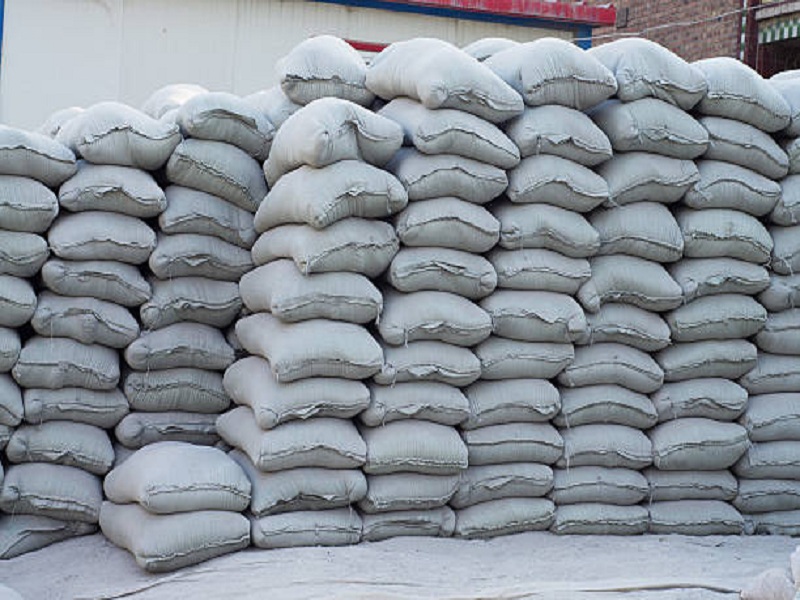Cement is a binder, a substance that sets and hardens independently, and can bind other materials together. The word "cement" traces to the Romans, who used the term opus caementicium to describe masonry resembling modern concrete that was made from crushed rock with burnt lime as binder. The volcanic ash and pulverized brick additives that were added to the burnt lime to obtain a hydraulic binder were later referred to as cement.
Cement used in construction is characterized as hydraulic or non-hydraulic. Hydraulic cements (e.g., Portland cement) harden because of hydration, chemical reactions that occur independently of the mixture's water content; they can harden even underwater or when constantly exposed to wet weather. The chemical reaction that results when the anhydrous cement powder is mixed with water produces hydrates that are not water-soluble. Non-hydraulic cements (e.g. gypsum plaster) must be kept dry in order to retain their strength.
The most important use of cement is the production of mortar and concrete—the bonding of natural or artificial aggregates to form a strong building material that is durable in the face of normal environmental effects.
Concrete should not be confused with cement, because the term cement refers to the material used to bind the aggregate materials of concrete. Concrete is a combination of a cement and aggregate.
Broadly cement is classified into two categories:
- OPC - Ordinary Portland cement
- PPC - Portland Pozzolana Cement
OPC - Ordinary Portland cement
OPC (Ordinary Portland Cement) is obtained by adding raw materials like calcareous materials and argillaceous materials. OPC (Ordinary Portland Cement) is the basic form of cement with 95% of it being the clinker and 5% being gypsum which is added as an additive to enhance the setting time of the cement to a workable 30 minutes odd or so. This cement is the standard norm being manufactured and sold by cement manufacturers around the world. OPC is environment friendly as well as economical. As the Understanding-Cement website puts it: "In particular, 'Ordinary Portland Cement' is the normal, grey, cement with which most people are familiar".
Ordinary Portland Cement (OPC-53, OPC-43, OPC-33) are the common grades.
OPC - Ordinary Portland cement
The 43 grade OPC is the most popular general-purpose cement in the country today. The production of 43 grade OPC is nearly 50% of the total production of cement in the country.
The 43 grade OPC can be used for following applications:
- General Civil Engineering construction work
- PPC - Portland Pozzolana Cement
- RCC works(preferably where grade of concrete is up to M-30)
- Pre-cast items such as blocks, tiles, pipes etc
- Asbestos products such as sheets and pipes
- Non-structural works such as plastering, flooring etc
- The compressive strength of cement when tested as per IS code shall be minimum 43 MPa.
The physical and chemical properties of this cement are given in the table:
- Physical Characteristics of 43 Grade OPC (BIS Requirement)
- Is Code Finene SS (sq.m/k g Min) Soundness by Setting Time Compressive Strength
- Lechatlier (mm)max Auto clave Max (%) Initial (mts) min Final (mts) Max 1 day Min Mpa 3 day Min Mpa 7 day Min Mpa 28 day Min Mpa
- (IS 8112- 1989) 225 10 0.8 30 600 Not specified 23 33 43
- Chemical Characteristics of 43 Grade OPC (BIS Requirement)
- Is Code Lime Saturation Factor Alumina Ration Min Insoluble MgO (%) Sulphuric Anhydride Loss ignition (%) Max
- (IS 8112 - 1989) 0.66 Min 1.02 Max 0.66 3 6 2.5% Max when C3A is 5 or less. 3% Max when C3A is greater than 5 5
Portland Pozzolana Cement (PPC) :
The Portland Pozzolana Cement is a kind of Blended Cement which is produced by either intergrinding of OPC clinker along with gypsum and pozzolanic materials in certain proportions or grinding the OPC clinker, gypsum and Pozzolanic materials separately and thoroughly blending them in certain proportions.
Pozzolana is a natural or artificial material containing silica in a reactive form. It may be further discussed as siliceous or siliceous and aluminous material which in itself possesses little, or no cementitious properties but will in finely divided form and in the presence of moisture, chemically react with calcium hydroxide at ordinary temperature to form compounds possessing cementitious properties. It is essential that pozzolana be in a finely divided state as it is only then that silica can combine with calcium hydroxide (liberated by the hydrating Portland Cement) in the presence of water to form stable calcium silicates which have cementitious properties.
The pozzolanic materials commonly used are:
Volcanic ash, Calcined clay, Fly ash, lica fumes.
Irrespective of the requirement of Cement, whether it is large or small, we are here to help our customers in every aspect
Global Trade Links Cement from the most renowned brands such as:
Our friendly and experienced team can help you to decide which size, grade and finish will work best for you. So for more information, help and advice, do send us an email at




